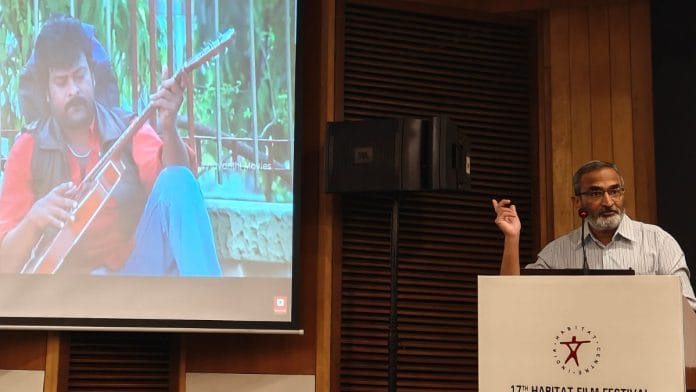New Delhi: There would be no pan-Indian films today without the mass films of the 80s and 90s, declared professor and author SV Srinivas, while delivering a talk on stardom and mass movies at Delhi’s India Habitat Centre. Titled Burdens of Superstardom: Looking Back at Rajinikanth and Chiranjeevi, the talk looked at the careers of the two superstars and how they have contributed to the evolution of mass films. It was part of the ongoing Habitat Film Festival 2025, which will conclude on 25 May.
“Chiranjeevi becomes increasingly risk-averse, as compared to Rajinikanth,” said Srinivas, who teaches courses in literature and media at Azim Premji University. “Rajinikanth must have been written off at least 150 times, with headlines like his career is finished, [but] he bounces right back”.
Srinivas traces the rise of mass Telugu films to the departure of NT Rama Rao, and the coming in of Chiranjeevi. In neighbouring Tamil Nadu, Rajinikanth, too, was making his mark as a popular actor. Before Chiranjeevi and Rajinikanth became stars, there was a greater variety in the kind of films they worked in. But slowly, they started gravitating toward massy films, with extravagant sets, songs, and dance sequences.
Both the actors started their career in the late 1970s. But as their stardom grew, the number of films became fewer, especially during the 1990s. Then came the resurgence in the 2000s.
“Enthiran or Robot (2010) started the regional blockbuster which we now call pan-Indian films. It brought together stars from across industries,” said Srinivas. The film had Aishwarya Rai opposite Rajinikanth, while the sequel, 2.0 (2018), had Akshay Kumar play the antagonist.
The Sivaji moment
Srinivas highlighted a feature common to all mass films—the movie becomes a re-narration of the extraordinary nature of the star. The common people are portrayed as devotees or fans of the protagonist. Rajinikanth’s Baba (2002) had led to speculation that the actor might enter politics. While Rajinikanth never ventured into active politics, Chiranjeevi did capitalise on his popularity to contest the 2009 Andhra Pradesh Assembly elections, and even won the Tirupati seat.
“The difference between Rajinikanth and Chiranjeevi in the 2000s is that the former had a Sivaji moment, he is getting to have a role that is self-reflexive and capable of making fun of his own earlier over-the-top films,” said Srinivas. For instance, a scene from Sivaji: The Boss (2007) refers to a popular moment from Rajinikanth’s 2005 hit Chandramukhi.
The professor also spoke about how Tamil director Pa Ranjith’s Kabali (2016) and Kaala (2018) shaped the kind of massy films Rajinikath does. “Kaala in particular is important because it is an Ambedkarite film, and the hero dies in the end,” he said.
Chiranjeevi decided to go back to his comfort zone, doing massy films that replicate his 90s movies, or remakes of hits in other languages, such as Godfather (2022), which also starred Salman Khan. It was the Telugu remake of the 2019 Malayalam film Lucifer.
Also read: When Shabana Azmi vowed to quit acting—she was humiliated on set by a choreographer
A common link
Before Chiranjveei became a megastar, he started out with films that revolved around caste dynamics, and doing roles that are either supporting, anti-hero, or antagonist. The one common link between Chiranjeevi and Rajinikanth is K Balachander, who made hard-hitting films that gave a leg-up to both the actors in their careers.
Rajinikanth made his debut with Balachander’s 1975 Tamil film Apoorva Raagangal, which also starred Kamal Haasan. 47 Natkal, a 1981 film where Chiranjeevi plays the role of a sadistic husband, opposite Jaya Prada, was also directed by Balachander.
Chiranjeevi started his career with Pranam Khareedu (1978), which had a climax similar to Shyam Benegal’s Nishant (1975). “Nishant’s climax becomes a set piece that is borrowed by a number of Telugu films, and recreated endlessly, especially by small Telugu films,” said Srinivas. Chiranjeevi later would mostly work in big-budget entertainers.
This also had to do with the fact that small films no longer seem to be viable in the Telugu film industry. Srinivas also pointed out that even OTTs now refuse to mount smaller films without a star face. “I got invited to deliver the talk here because there is no film festival worthy of Telugu film,” he said with a smile.
(Edited by Aamaan Alam Khan)






